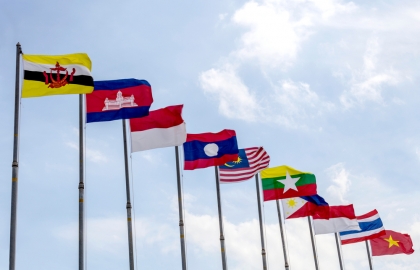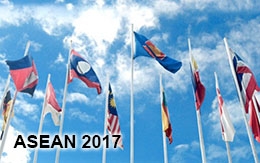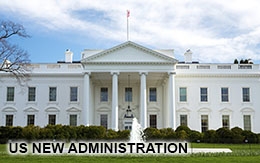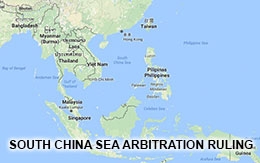ASEAN and South China Sea in 2017
The Maritime Issues conducts an interview with Kavi Chongkittavorn, a veteran ASEAN watcher who is a senior fellow at the Institute of Security and International Studies, Chulalongkorn University (Thailand) on all issues related to ASEAN and its South China Sea agenda.

As the tensions in the South China Sea have flared up without signs of abating, ASEAN as a regional grouping has faced mounting criticisms for its failures to manage the relations between China and its members. It is very hard for ASEAN to claim a role of centrality in Asia-Pacific politics without capacity to stabilise the maritime region at its doorstep. The future of this organisation is more uncertain with the new leadership in the Philippines, the country that assumes ASEAN chairmanship in 2017.
The Maritime Issues conducts an interview with Kavi Chongkittavorn, a veteran ASEAN watcher who is a senior fellow at the Institute of Security and International Studies, Chulalongkorn University (Thailand) on all issues related to ASEAN and its South China Sea agenda.
------------
1.What is the likelihood of ASEAN’s modification of its consensus principle due to disagreements on the South China Sea issue?
ANSWER: The consensus principle of ASEAN is sacrosanct and it must be not modified. Throughout out its 49 years, ASEAN disagreed on many things before on myriads of region and global issues--not only over the SCS dispute. For instance, the Cambodian issue was divisive, as the ASEAN members could not agree on approaches to settle the conflict. However, through consultation and perseverance, slowly and surely all members then came together for the grouping’s survival. Disagreements included other non-ASEAN issues such as the Palestine-Israel conflict, Ukraine and others. These issues have nothing to do with the issues of national sovereignty.
What is needed now is a better way to reach a decision that has the greatest common points. A proposal “to strengthen the capacity of ASEAN decision makers to make timely decisions on crucial issues affecting peace and stability in the region” would be welcome. It could gain supports if one or two members champion it. The role of rotating chair is the most crucial.
2. Some observers suggested that an ASEAN-X approach, or a caucus of Southeast Asian claimants within ASEAN, should be adopted on the South China Sea issues? Is it possible? If such a caucus is institutionalized, what would be the implications for the region as a whole?
ANSWER: Anything is possible in ASEAN, indeed. It depends on time and factors at a decisive moment. ASEAN pushed the ASEAN Convention on Counter-Terrorism in 2007 only after 90 working days. It was a miracle. Why? Indonesia and Philippines wanted it badly. So, if any ASEAN member wants to push for any particular action plan, it can, of course mindful of the consensus. For now, the ASEAN-x approach is good for the economy and it could be applied for selective political issues. Indeed, the words “some” in the joint ASEAN statements on the disagreements over the SCS issue was reflected in August 2014 and during the ASEAN ministerial meeting in Kuala Lumpur in 2015. Unofficially, it was the minus-x formula. ASEAN needs a TOR when it is applicable to use the minus-x formula.
3. Please assess the impacts of the Duterte administration’s rebalancing on its South China Sea policy and the agenda of ASEAN during the Philippines’ chairmanship of ASEAN in 2017.
ANSWER: So far so good, China is willing to adopt softer approaches at least for the time being to appease the Philippines and ASEAN as a whole. To have Manila returned to the grouping embrace is a positive development for China’s foreign policy. To pursue a softer attitude toward ASEAN in the past three years with the US pressure at its head was not possible. It could be construed as giving in to Washington’s influence. The question is now how far both Philippines and China are willing to go and what would be the long-term ramification of their improved relations. If their joint actions and proposed activities do not undermine the ASEAN centrality or solidarity, that would be welcome by all as they would be treated as bilateral matters such as the China-Thai, China-Cambodia, China-Laos, etc.
4. What are your assessments on the recent trip to China of Malaysia's Prime Minister? Does it signal a signification shift to Malaysia’s foreign policy and its South China Sea policy?
ANSWER: Among ASEAN countries, Malaysia has the most sophisticated and dynamic ties with China, very holistic ones indeed. Unlike, for an instance, the Thai-China relations are very fundamental and not as solid as its southern neighbor. Malaysia knows the realpolitik. Prime Minister Tunku Razak Najib deliberately showed to Washington that he alone could deliver and shift policies towards the USA. So, Washington has to be mindful of its comments and actions towards Najib’s leadership at this juncture (the same attitude Mahathir took after Al Gore’s fiasco).
It is a strong signal of his confidence to the US and other countries as well. Kuala Lumpur helped the US a lot over the past two years, allowing its sky to be used by the US forces (Thailand refused to do so due to the US condescending attitude) for the surveillance missions in the Indian Ocean. China has been friendly to Malaysia all along, so it will continue. It is not a domino as some Western scholars suggested. Kuala Lumpur got the TPP and overcome the TIP (Trafficking in Persons Report) debacle two years ago. The next American president needs to work a new policy toward the region with some new and old elements.
I don’t think the next US president will emphasis on the SCS issue, even if Clinton wins. For six years, the US helped to internationalize the SCS for fear that the conflict would drag the US into a real conflict with china. The PCA award was the final product of the US effort. Now it can release the safety valve a bit for the time being./.









